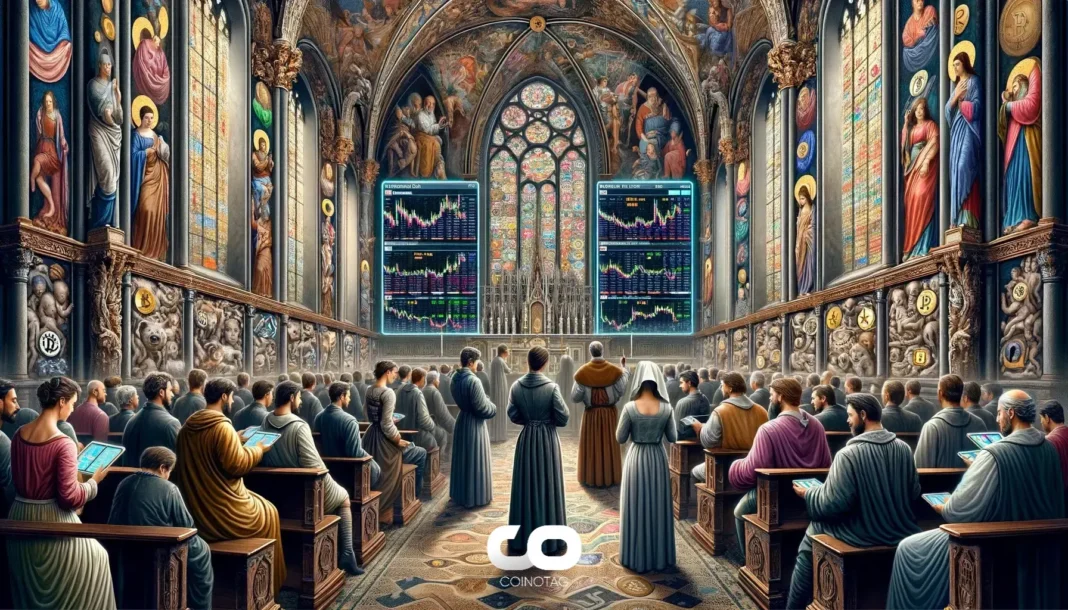| COINOTAG recommends • Exchange signup |
| 💹 Trade with pro tools |
| Fast execution, robust charts, clean risk controls. |
| 👉 Open account → |
| COINOTAG recommends • Exchange signup |
| 🚀 Smooth orders, clear control |
| Advanced order types and market depth in one view. |
| 👉 Create account → |
| COINOTAG recommends • Exchange signup |
| 📈 Clarity in volatile markets |
| Plan entries & exits, manage positions with discipline. |
| 👉 Sign up → |
| COINOTAG recommends • Exchange signup |
| ⚡ Speed, depth, reliability |
| Execute confidently when timing matters. |
| 👉 Open account → |
| COINOTAG recommends • Exchange signup |
| 🧭 A focused workflow for traders |
| Alerts, watchlists, and a repeatable process. |
| 👉 Get started → |
| COINOTAG recommends • Exchange signup |
| ✅ Data‑driven decisions |
| Focus on process—not noise. |
| 👉 Sign up → |
- Fidelity, a leading financial services company, has published a report on the cryptocurrency market, with a particular focus on Ethereum (ETH).
- The report highlights that the Ethereum network experienced its highest inflation period during the second quarter.
- Analysts noted a 20% increase in layer-2 transactions since the Dencun update in March, which is a significant development for the network.
Discover the latest insights from Fidelity’s report, uncovering key trends and future prospects for Ethereum in the evolving cryptocurrency market.
Ethereum’s Inflation and Network Activity Surge in Q2
In its latest report, Fidelity outlined that the Ethereum blockchain added approximately 110,000 ETH to its total supply in the last quarter. This has resulted in an annual inflation rate of 0.37%. Despite this uptick, short-term and mid-term dramatic fluctuations in Ethereum’s supply are not anticipated. This cautious outlook is attributed to the growing interest in layer-2 platforms and increasing staking demand.
Increased Validator Participation and Staking Trends
According to the report, there has been a 5% increase in the number of validators on the Ethereum network since April. Fidelity analysts Daniel Gray and Max Wadington pointed out that new re-staking implementations could drive further demand in staking. The robust activity in the staking landscape underscores a healthy engagement from the community despite inflationary pressures. Additionally, spot Ethereum Exchange-Traded Funds (ETFs) started trading in the U.S. on Tuesday, potentially broadening access to the cryptocurrency.
Market Reactions and Layer-2 Ecosystem Growth
Spot Ethereum ETFs represent a major milestone, poised to grant broader market access to cryptocurrency investors. However, some major firms are cautioning that the initial demand for these ETFs might be lower than anticipated. Meanwhile, the layer-2 ecosystem continues to thrive, recording a 20% increase in activities since the recent protocol upgrade. Layer-2 solutions, built atop primary blockchains, are revolutionizing transaction efficiency and scalability.
| COINOTAG recommends • Professional traders group |
| 💎 Join a professional trading community |
| Work with senior traders, research‑backed setups, and risk‑first frameworks. |
| 👉 Join the group → |
| COINOTAG recommends • Professional traders group |
| 📊 Transparent performance, real process |
| Spot strategies with documented months of triple‑digit runs during strong trends; futures plans use defined R:R and sizing. |
| 👉 Get access → |
| COINOTAG recommends • Professional traders group |
| 🧭 Research → Plan → Execute |
| Daily levels, watchlists, and post‑trade reviews to build consistency. |
| 👉 Join now → |
| COINOTAG recommends • Professional traders group |
| 🛡️ Risk comes first |
| Sizing methods, invalidation rules, and R‑multiples baked into every plan. |
| 👉 Start today → |
| COINOTAG recommends • Professional traders group |
| 🧠 Learn the “why” behind each trade |
| Live breakdowns, playbooks, and framework‑first education. |
| 👉 Join the group → |
| COINOTAG recommends • Professional traders group |
| 🚀 Insider • APEX • INNER CIRCLE |
| Choose the depth you need—tools, coaching, and member rooms. |
| 👉 Explore tiers → |
Ethereum Valuation and Market Sentiment
Fidelity’s report highlighted an interesting market dynamic where Ethereum is currently trading 67% above its realized price. This could be an indication that investors are more comfortable allocating funds to Ethereum compared to the peaks seen in 2021. However, the fundamental metrics for Ethereum’s base layer have shown some signs of decline in the second quarter, with monthly new addresses dropping by 16%, active addresses falling by 14%, and transactions decreasing by 9%. This trend hints at a possible shift in valuation drivers from base layer metrics towards the burgeoning layer-2 ecosystem.
Conclusion
In summary, Fidelity’s report provides a comprehensive look at Ethereum’s performance and the evolving dynamics within its network. The report underscores the healthy growth in validator participation and staking, despite the inflationary period witnessed in the last quarter. Furthermore, the surge in layer-2 activities marks a pivotal development, suggesting a shift in value assessment from traditional base layer metrics. With spot Ethereum ETFs now trading, the future of Ethereum in the investment landscape looks promising, albeit with measured optimism from industry experts.
| COINOTAG recommends • Exchange signup |
| 📈 Clear interface, precise orders |
| Sharp entries & exits with actionable alerts. |
| 👉 Create free account → |
| COINOTAG recommends • Exchange signup |
| 🧠 Smarter tools. Better decisions. |
| Depth analytics and risk features in one view. |
| 👉 Sign up → |
| COINOTAG recommends • Exchange signup |
| 🎯 Take control of entries & exits |
| Set alerts, define stops, execute consistently. |
| 👉 Open account → |
| COINOTAG recommends • Exchange signup |
| 🛠️ From idea to execution |
| Turn setups into plans with practical order types. |
| 👉 Join now → |
| COINOTAG recommends • Exchange signup |
| 📋 Trade your plan |
| Watchlists and routing that support focus. |
| 👉 Get started → |
| COINOTAG recommends • Exchange signup |
| 📊 Precision without the noise |
| Data‑first workflows for active traders. |
| 👉 Sign up → |
| COINOTAG recommends • Members‑only research |
| 📌 Curated setups, clearly explained |
| Entry, invalidation, targets, and R:R defined before execution. |
| 👉 Get access → |
| COINOTAG recommends • Members‑only research |
| 🧠 Data‑led decision making |
| Technical + flow + context synthesized into actionable plans. |
| 👉 Join now → |
| COINOTAG recommends • Members‑only research |
| 🧱 Consistency over hype |
| Repeatable rules, realistic expectations, and a calmer mindset. |
| 👉 Get access → |
| COINOTAG recommends • Members‑only research |
| 🕒 Patience is an edge |
| Wait for confirmation and manage risk with checklists. |
| 👉 Join now → |
| COINOTAG recommends • Members‑only research |
| 💼 Professional mentorship |
| Guidance from seasoned traders and structured feedback loops. |
| 👉 Get access → |
| COINOTAG recommends • Members‑only research |
| 🧮 Track • Review • Improve |
| Documented PnL tracking and post‑mortems to accelerate learning. |
| 👉 Join now → |






